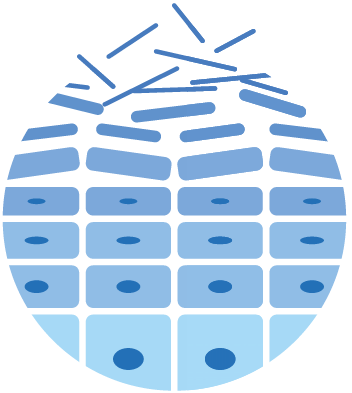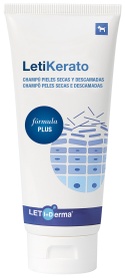LetiKerato
For seborrhoeic, dry and flaky skin
The Kerato line contains gluconolactone in addition to other ingredients such as urea and salicylic, lactic, glycolic, citric, malic and tartaric acids, which possess keratolytic and keratoplastic properties to cleanse the skin and remove dead cells.
Gluconolactone
The most important active substance is gluconolactone, with several beneficial effects for the skin:
Keratolytic
Removes the remains of dead cells in the stratum corneum. Exfoliating effect (1).
Keratoplastic
Promotes the reconstruction of the epidermal barrier and the production of lipids in the skin (2).
Moisturising
Attracts and incorporates water molecules in the epidermis, creating a protective film on the skin (3).
Antioxidant
Traps and scavenges free radicals, protecting against the harmful effects of UV radiation. (4).
Antimicrobial
Acidifies the stratum corneum, limiting microbial growth (5).
It is not an irritant, so it can even be used on animals with sensitive skin
Gluconolactone applied topically promotes the acidification of the stratum corneum, improves the action of ceramides, favors the maturation of the lipids of the epidermis and increases the cohesion between corneocytes, enhancing the barrier effect.
Bibliography
- Berardesca E, Distante F, Vignoli GP, Oresajo C, Green B. Alpha hydroxyacids modulate stratumcorneumbarrierfunction. Br J Dermatol 1997;137:934-938.
- Hachem JP, Roelandt T, Schürer N, Pu X, Fluhr J, Giddelo C, Man M-Q, Crumrine D, Roseeuw D, Feingold KR, Mauro T, Elias PM. Acute acidification of stratum corneum membrane domains using polyhydroxyl acids improves lipid processing and inhibits degradation of corneodesmosomes. J Invest Dermatol. 2010;130:500-10.
- National Center for Biotechnology Information. PubChem Compound Database; CID=7027, https://pubchem.ncbi.nlm.nih.gov/compound/7027.
- Bernstein EF, Brown DB, Schwartz MD, Kaidbey K, Ksenzenko SM. The polyhydroxy acid gluconolactone protects against ultraviolet radiation in an in vitro model of cutaneous photoaging. Dermatol Surg. 2004;30:189-196.
- Chan A, Mauro T. Acidification in the epidermis and the role of secretory phospholipases. Dermatoendocrinol. 2011;3:84-90.
- Puigdemont A, Furiani N, De Lucia M, Carrasco I, Ordeix L, Fondevila D, Ramió-Lluch L, Brazis P. Topical polyhydroxy acid treatment for autosomal recessive congenital ichthyosis in the golden retriever: a prospective pilot study. Vet Dermatol. 2018; 29: 323-e113. May 22. doi: 10.1111/vde.12654. Request article
- Carrasco I, Puigdemont A, Ramió-Lluch L, de Lucía M, Furiani N, Ordeix L, Brazís P. Eficacia de una terapia tópica, con polihidroxiácidos, en la ictiosis del Golden retriever: estudio prospectivo. Poster. 16th Congreso de Especialidades Veterinarias GTA/AVEPA. Bilbao (Spain) 2017. Download poster
- Arrizabalaga A, Pol G. Dermatosis seborreica del borde auricular en tres perros de raza Chihuahua y resolución con gluconolactona y urea. Poster. 16th Congreso de Especialidades Veterinarias GTA/AVEPA. Bilbao (Spain) 2017. Download poster
- Puigdemont A, Furiani N, Fondevila D, Ramió-Lluch L, Brazís P. Polyhydroxy acid-based topical treatment for ichthyosis in the golden retriever: histopathological findings. Poster. North American Veterinary Dermatology Forum (NAVDF). Maui, Hawaii. (USA). 2018. Abstract published in: VetDermatol 2018; 29: 287. Download poster
- R. Foj, G. Pol, S. Vivancos, S. Usero, P. Brazis, A. Puigdemont. LetiKerato Shampoo and Lotion efficacy as an adjunct treatment in canine leishmaniosis keratoseborrheic skin lesions. Poster presented at 1st congress ALIVE 2022 (Málaga, Spain). Download poster










